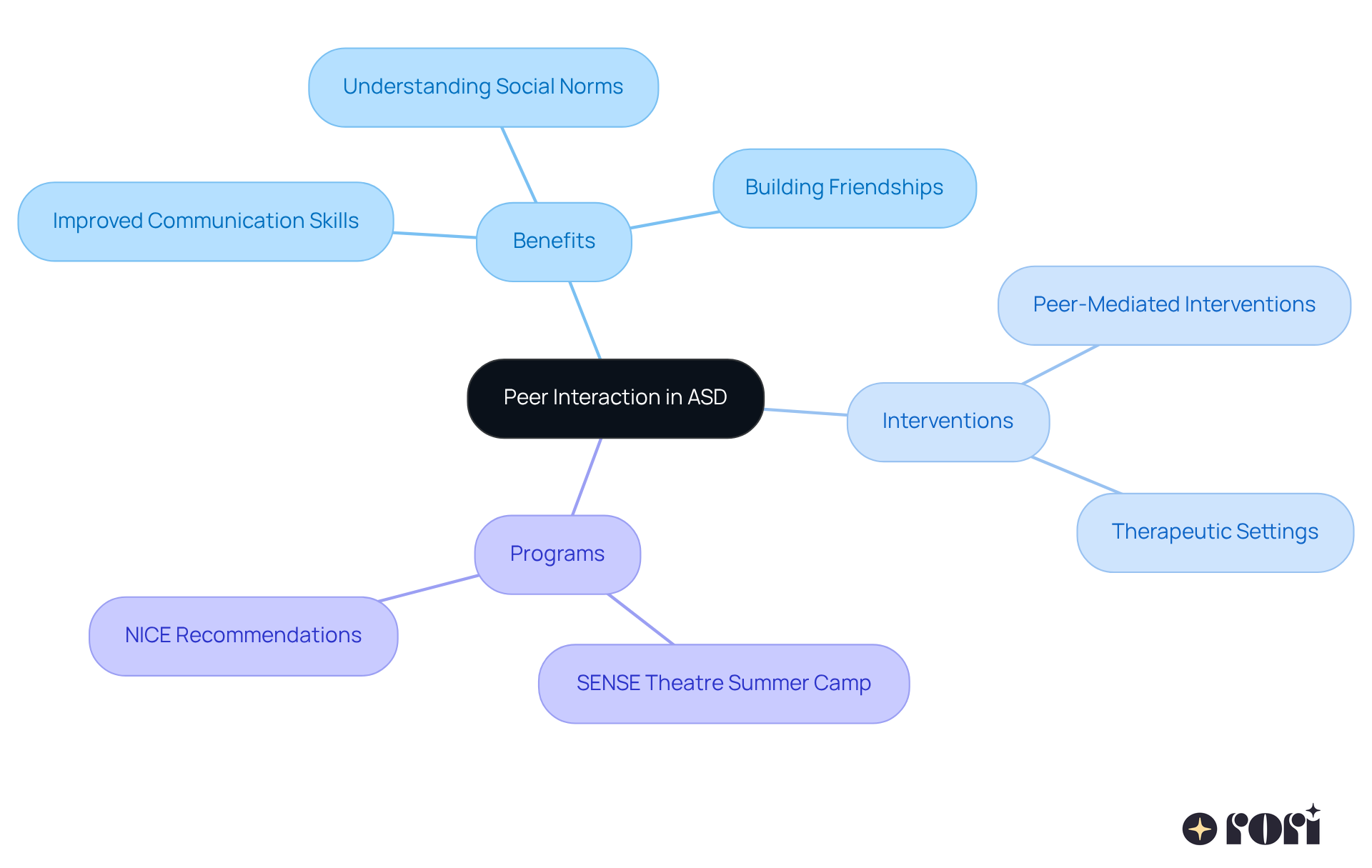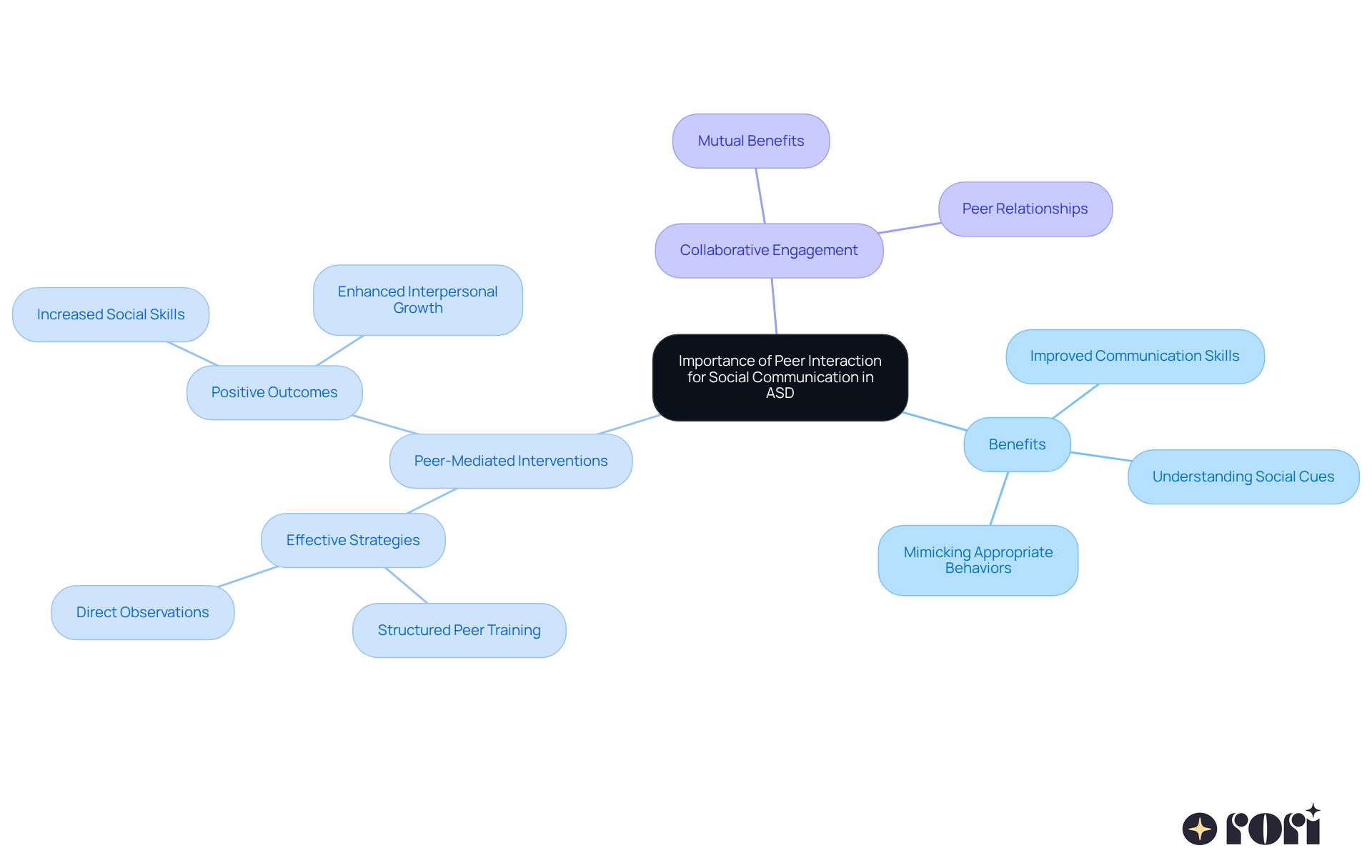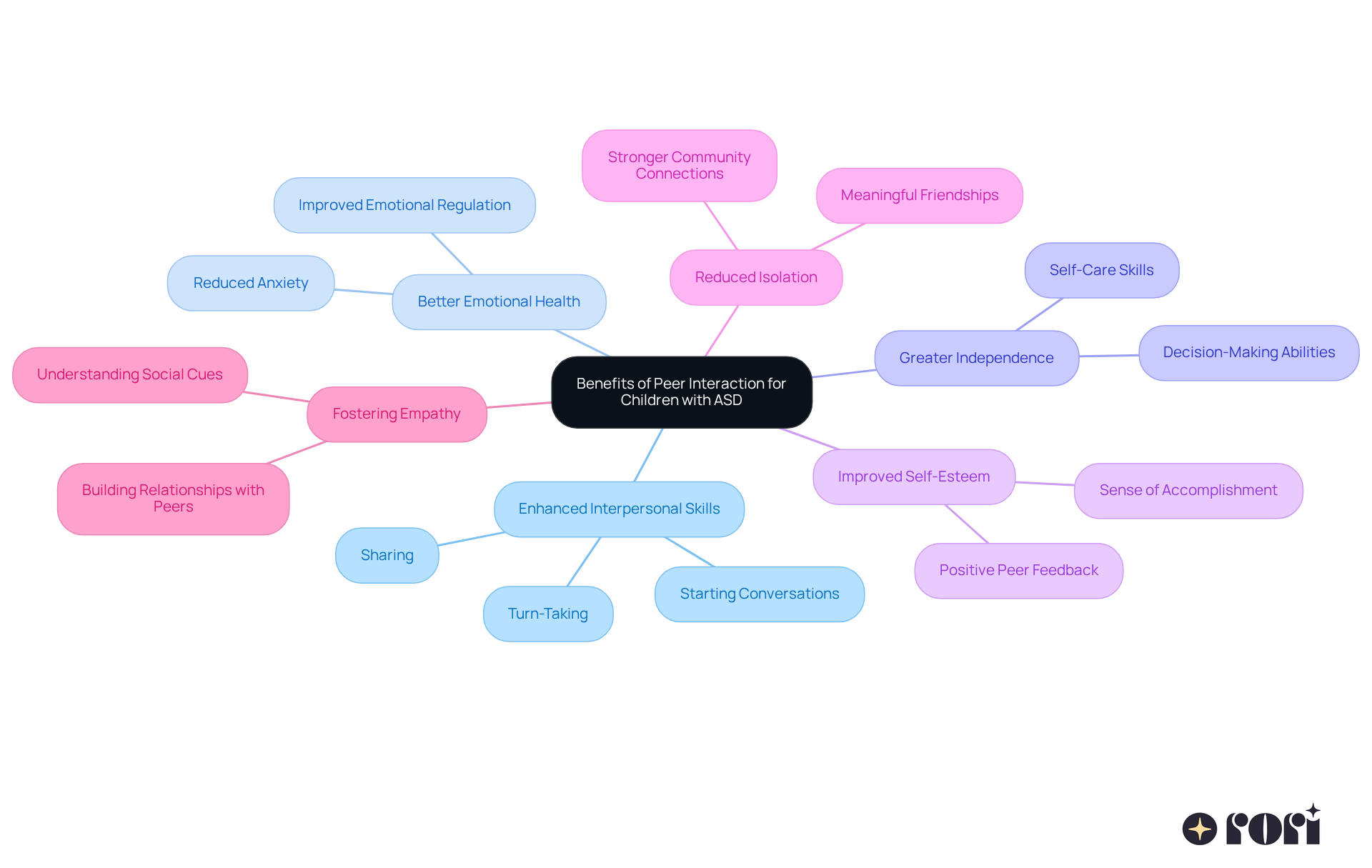Engagement among peers is so important for developing social communication skills, especially for children with Autism Spectrum Disorder (ASD). Through meaningful interactions, these young individuals can really boost their interpersonal abilities, understand social norms, and build friendships - things that are crucial for their growth.
But let’s be real: the journey to fostering effective peer connections can be tough. Kids with ASD often face challenges like interpreting social cues and starting conversations. So, how can caregivers and educators create supportive environments that not only encourage these interactions but also maximize their benefits for children with ASD?
Let’s explore this together! By creating spaces where kids feel safe and understood, we can help them thrive in their social skills. It’s all about those little moments of connection that can make a big difference. We’re here to help you every step of the way!
Engagement among young individuals, especially those with Autism Spectrum Disorder (ASD), is so important! It includes the exchanges between children, particularly when they play, chat, or work together. These interactions provide the benefits of peer interaction for social communication in ASD, helping kids with autism to build interpersonal skills, understand social norms, and make friends.
Research shows that the benefits of peer interaction for social communication in ASD can significantly boost communication skills for youngsters. For instance, peer-mediated interventions (PMIs) have been found to greatly enhance interpersonal abilities. Kids in the PMI group often show more substantial improvements compared to those in traditional behavioral therapies. Isn’t that encouraging?
Programs like the SENSE Theatre Summer Camp have done wonders by engaging participants in interactive activities with youths who have ASD. The results? Significant advancements in support and communication! Plus, the National Institute for Health and Care Excellence (NICE) emphasizes the importance of communication interventions that focus on play and group engagement. These exchanges are crucial in therapeutic settings.
At Rori Care, our clinical leadership team is all about neurodiversity and supporting young individuals. We empower caregivers with the knowledge and skills they need to help their kids achieve their behavioral goals through ABA principles. This involvement not only enhances the impact of interventions but also boosts the effectiveness of group therapy for interpersonal skills led by qualified therapists. It’s all about fostering better connections and communication among everyone involved.
Overall, encouraging peer engagement showcases the benefits of peer interaction for social communication in ASD, which helps kids develop essential interpersonal skills while fostering a more inclusive atmosphere for youths with ASD. Let’s explore this together and see how we can make a difference!

The benefits of peer interaction for social communication in ASD are essential for helping kids with autism spectrum disorder improve their communication skills. When they get to interact in real-life situations, these youngsters can practice and boost their abilities. Through conversations with peers, they pick up on social cues, understand the nuances of dialogue, and learn to share their thoughts and feelings more effectively. Plus, these interactions give kids a chance to observe and mimic appropriate social behaviors, which really helps them grow in their interpersonal skills.
At Rori Care, our clinical leadership team truly values neurodiversity and is all about empowering caregivers with ABA principles and strategies. We work hand-in-hand with families to roll out effective peer-mediated interventions (PMIs) that encourage regular peer interactions. Research shows that these engagements can lead to significant improvements in communication skills. In fact, studies have found that PMIs can lead to noticeable enhancements in interpersonal skills, with effect sizes ranging from small to large. About 80% of studies looking into how these skills generalize reported positive outcomes, highlighting just how effective these interactions can be in different settings.
Moreover, an analysis of collaborative engagement studies revealed that kids with mild to moderate ASD made greater strides in their interpersonal skills compared to those in traditional therapies. Most of the regular classmates involved in these programs shared that they enjoyed the experience and felt they gained both academically and socially. This really underscores the mutual benefits of social interactions! Overall, the benefits of peer interaction for social communication in ASD are key to enhancing communication skills and fostering interpersonal growth in kids.
Let’s explore this together! If you’re looking for ways to support your child’s journey, we’re here to help you every step of the way!

Collaborative engagement provides significant benefits of peer interaction for social communication in ASD for youth with autism spectrum disorder. Think about enhanced interpersonal skills, better emotional health, and greater independence! When kids participate in skills group therapy with their classmates, guided by qualified therapists, they can enjoy the benefits of peer interaction for social communication in ASD while practicing important skills like turn-taking, sharing, and starting conversations. Creating a structured environment helps improve communication and build vital interpersonal relationships, showcasing the benefits of peer interaction for social communication in ASD.
And here’s the great part: the benefits of peer interaction for social communication in ASD can significantly boost self-esteem and help reduce feelings of isolation. Kids with ASD who take part in these therapeutic exchanges often demonstrate remarkable progress, highlighting the benefits of peer interaction for social communication in ASD. This leads to more meaningful friendships and demonstrates the benefits of peer interaction for social communication in ASD, fostering a stronger sense of belonging in their communities. Plus, these interactions can help foster the benefits of peer interaction for social communication in ASD, promoting empathy and understanding among their typically developing peers and creating a more inclusive atmosphere for everyone.
Overall, interpersonal skills group therapy is designed to enhance competence and confidence for individuals with Autism, ADHD, Communication Disorders, Anxiety Disorders, and others, highlighting the benefits of peer interaction for social communication in ASD to improve their interpersonal abilities. So, let’s explore this together! We’re here to help you every step of the way!

Promoting connections among youngsters with autism spectrum disorder (ASD) can be quite a journey, often filled with hurdles. Many kids with ASD struggle with interpreting cues, starting conversations, and keeping dialogues going. It’s not uncommon for them to feel anxious in social settings, which might lead to avoiding peer interactions altogether. Plus, without structured opportunities for social engagement, their chances to practice those essential social skills can dwindle.
At Rori Care, we understand these challenges, and that’s why our clinical leadership team - made up of skilled and caring professionals - is dedicated to supporting neurodiversity and the success of youth. We use peer-mediated approaches, where typically developing peers are trained to assist and interact with individuals with ASD through fun activities like group games and collaborative projects. These strategies have shown great promise in fostering meaningful connections.
We also offer educational programs for caregivers, focusing on enhancing their understanding of ASD and providing them with resources to support their child’s growth. By creating inclusive environments that encourage interaction through organized play and skills training, we can significantly enhance the benefits of peer interaction for social communication in ASD.
Let’s explore this together! By implementing these strategies, children with ASD can build the confidence and skills necessary to realize the benefits of peer interaction for social communication in ASD.
Exploring peer interaction in the context of Autism Spectrum Disorder (ASD) is so important! It plays a vital role in helping children enhance their social communication skills. When we encourage these interactions, kids with ASD can develop essential interpersonal abilities, gain confidence, and form meaningful connections. It’s amazing to see how these social exchanges can transform lives, especially in therapeutic settings where structured opportunities for interaction are key.
Key insights from the article show that peer-mediated interventions can lead to significant improvements in communication skills, often surpassing traditional behavioral therapies. Programs like SENSE Theatre Summer Camp and collaborative engagement strategies have had remarkable success in helping children with ASD navigate social cues and build relationships. Plus, the benefits of these interactions go beyond individual growth; they promote empathy and understanding within inclusive environments.
Ultimately, prioritizing peer interaction is crucial for nurturing the social development of children with ASD. By implementing effective strategies and fostering supportive communities, caregivers and professionals can help these children thrive. Let’s unlock their potential for meaningful social connections together! Embracing the power of peer relationships not only enhances the lives of children with autism but also cultivates a more inclusive society for all. We’re here to help you every step of the way!
What is peer interaction in the context of Autism Spectrum Disorder (ASD)?
Peer interaction refers to the exchanges between children, especially those with ASD, during activities such as playing, chatting, or working together. These interactions are crucial for helping kids with autism build interpersonal skills, understand social norms, and make friends.
How does peer interaction benefit social communication in children with ASD?
Peer interaction significantly boosts communication skills for children with ASD. Research indicates that peer-mediated interventions (PMIs) lead to greater improvements in interpersonal abilities compared to traditional behavioral therapies.
Can you give an example of a program that enhances peer interaction for children with ASD?
The SENSE Theatre Summer Camp is an example of a program that engages participants in interactive activities with youths who have ASD, resulting in significant advancements in support and communication.
What does the National Institute for Health and Care Excellence (NICE) say about communication interventions for children with ASD?
NICE emphasizes the importance of communication interventions that focus on play and group engagement, highlighting the crucial role of these exchanges in therapeutic settings.
How does Rori Care support young individuals with ASD and their caregivers?
Rori Care's clinical leadership team focuses on neurodiversity and empowers caregivers with the knowledge and skills needed to help their children achieve behavioral goals through ABA principles, enhancing the effectiveness of group therapy for interpersonal skills.
Why is encouraging peer engagement important for children with ASD?
Encouraging peer engagement helps children with ASD develop essential interpersonal skills and fosters a more inclusive atmosphere for youths with ASD, benefiting their overall social communication.